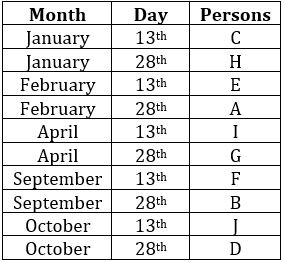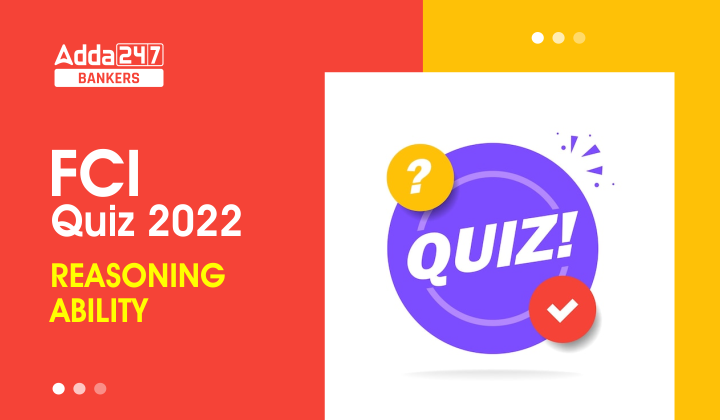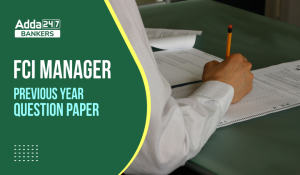Directions (1-5): Study the information and answer the following questions:
Eight persons K, L, M, N, O, P, Q and R sitting in a row. Some of them are facing north while some are facing south. N and M sits 5th to the right of each another but none of them sits at an extreme end. L and K sits third to the left of each another but none of them sits at an extreme end. Q sits third to the right of N. P sits second to the right of L. R sits third to the left of P. K sits second to the left of O. Both the person sitting at extreme ends faces opposite direction to each other. R sits to the left of L and both of them are facing opposite direction to each other. Q does not face south direction. Not more than two persons sitting together face same direction.
Q1. Who among the following sits third to the right of R?
(a) Q
(b) K
(c) M
(d) N
(e) None of these
Q2. Which among the following pair sit at the end of the row?
(a) Q, L
(b) R, K
(c) O, P
(d) L, R
(e) None of these
Q3. How many persons sits to the right of K?
(a) Two
(b) More than Three
(c) Three
(d) One
(e) None of these
Q4. Who among the following sits second to the right of Q?
(a) L
(b) N
(c) M
(d) O
(e) None of these
Q5. Four of the following are alike in a certain way so form a group, which of the following does not belong to that group?
(a) K
(b) N
(c) R
(d) O
(e) P
Directions (6-10): In these questions, relationship between different elements is shown in the statements. These statements are followed by two conclusions:
Q6.

(a) If only conclusion I follows.
(b) If only conclusion II follows.
(c) If either conclusion I or II follows.
(d) If neither conclusion I nor II follows.
(e) If both conclusion I and II follow.
Q7.

(a) If only conclusion I follows.
(b) If only conclusion II follows.
(c) If either conclusion I or II follows.
(d) If neither conclusion I nor II follows.
(e) If both conclusion I and II follow.
Q8.

(a) If only conclusion I follows.
(b) If only conclusion II follows.
(c) If either conclusion I or II follows.
(d) If neither conclusion I nor II follows.
(e) If both conclusion I and II follow.
Q9.

(a) If only conclusion I follows.
(b) If only conclusion II follows.
(c) If either conclusion I or II follows.
(d) If neither conclusion I nor II follows.
(e) If both conclusion I and II follow.
Q10.

(a) If only conclusion I follows.
(b) If only conclusion II follows.
(c) If either conclusion I or II follows.
(d) If neither conclusion I nor II follows.
(e) If both conclusion I and II follow.
Directions (11-15): Study the information and answer the given questions:
There are ten persons namely A, B, C, D, E, F, G, H, I & J. They got appointments on 13th and 28th of different months i.e., January, February, April, September, October but not necessarily in the same order.
A has appointment in a month which has less than 30 days. Two persons have appointment between A and F. Only two persons have appointment after B. H has appointment on an even date of a month which has more than 30 days and immediate before E. D has appointment after B but not on odd date. I has appointment immediate before G and doesn’t have appointment on even date. C has appointment before G.
Q11. Who among the following got appointment in the month which having less than 30 days?
(a)E
(b)F
(c)B
(d)A
(e)Both (a) and (d)
Q12. Four of the following five are alike in a certain way and hence they form a group. Which one of the following does not belong to that group?
(a) J
(b) F
(c) D
(d) C
(e) I
Q13. Who among the following are the persons who got appointment at first and at last?
(a) E, J
(b) F, B
(c) D, A
(d) C, D
(e) I, C
Q14. How many persons got appointment between E and B?
(a) No one
(b) More than four
(c) Three
(d) Four
(e) Two
Q15. Who among the following got appointment on 13th April?
(a) A
(b) F
(c) D
(d) C
(e) I
Solutions
Solutions (1-5):
Sol.

S1. Ans. (c)
S2. Ans. (c)
S3. Ans. (a)
S4. Ans. (a)
S5. Ans. (e)
S6. Ans. (b)
Sol. I. C>A (False)
II. E>B (True)
S7. Ans. (e)
Sol. I. D≤C (True)
II. L>D (True)
S8. Ans. (d)
Sol. I. Q>I (False)
II. M≥S (False)
S9. Ans. (c)
Sol. I. J≥Q (False)
II. Q>J (False)
S10. Ans. (c)
Sol. I. N≥R (False),
II. N<R (False)
Solutions (11-15):
Sol.

S11. Ans. (e)
S12. Ans. (c)
S13. Ans. (d)
S14. Ans. (d)
S15. Ans. (e)





 FCI Assistant Grade 3 Previous Year Ques...
FCI Assistant Grade 3 Previous Year Ques...
 FCI Manager Previous Year Question Paper...
FCI Manager Previous Year Question Paper...
 FCI DV Admit Card 2023 Out, Download FCI...
FCI DV Admit Card 2023 Out, Download FCI...





